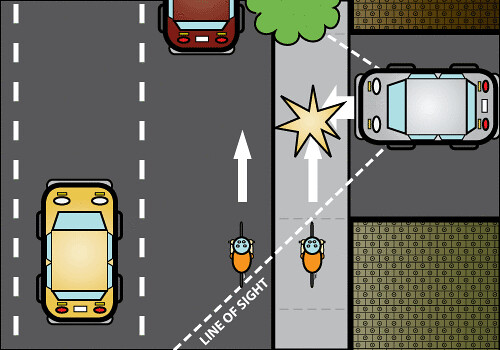
Now, I will openly say that this is a rather controversial tip. Best case scenario, you live in a bike friendly part of the city, and your tax dollars have gone towards painting and maintaining bike lanes. Worst case scenario, you are given two choices: sidewalk or street. In that case, I almost always choose the street.
Although Florida, among other states, allows cyclists to ride on the sidewalk, there are very few circumstances where this is the best decision (for Florida state bike laws, click
here). The sidewalk is not designed for moving vehicles. It is not regularly maintained in the same way that streets are. And it is filled with many physical obstacles for a cyclist: street signs, bus benches, random poles, and pedestrians. Plus, as you can see in the image I have shared, a motorist turning into traffic isn't looking for quickly approaching cyclists on the sidewalk (if they are looking to the sidewalk at all).
If there is no bike lane, there are two alternatives that are better than the sidewalk: take an entire lane (legally justified) or take half of the lane. My first few months on a bike, I took the entire right lane. Although I definitely felt safe, I was constantly heckled by passing motorist. After many trips attempting to ignore the ignorance of inconsiderate motorists, I decided to only take half of the lane.
Taking half of the lane has significantly lowered the number of altercations with motorists, but it has its own drawbacks. When I am only taking half of the lane, many motorist attempt to zoom by me without changing lanes; this has caused many close calls. If that isn't enough, poorly kept roads are usually worst along their edges. This is where I have come across the worst erosion and also where all the glass and medal from accidents is brushed to...
At the end of the day, it is all about being aware. No general strategy works in every case. It is really important that all factors be taken into consideration to ensure that you safely get from point A to B.
So read up on your State laws, stay alert, and enjoy your ride : )




